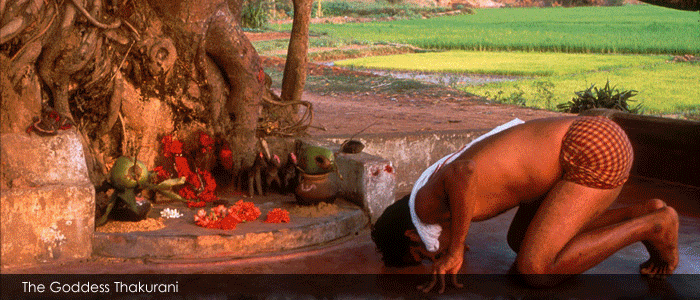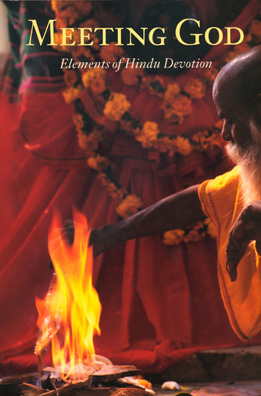

September 28, 1999 - January 2, 2000
Houston Museum of Natural History
September 10, 2001 - February 10, 2002 |
American Museum of Natural History, New York
Related Links
Order Meeting God (the book) from Amazon.comOrder Meeting God greeting cards
Book reviews for Meeting God

Acknowledgements
For their aid in facilitating this exhibition, Dr. Huyler would like to thank: Mrs. Sunithi Narayan, Maheswar Mohapatra, Prabhat and Sushmita Tandan, P.R. Tippeswamy, Dr. Jyotindra Jain, Air Marshall and Mrs. G. B. Singh, Cheryl Smith, Helene Huyler, Elizabeth Garber Baldwin, Ivan Stancioff, Karen Lukas, Joseph Guglietti, Sarah Ridley, Dr. Milo Beach, The Arthur M. Sackler Gallery-Smithsonian Institution, The Foreside Company, Lisa Rebori, Janice M. Glowski and The Huntington Archive, and the innumerable households, community shrines, and temples that have graciously allowed their images and rituals to be photographed.
About Stephen P. Huyler
Stephen P. Huyler is an art historian, cultural anthropologist, photographer, and author. He has spent a large part of the last twenty-eight years traveling in Indian villages documenting craftsmanship and contemporary traditions. His focus during the past decade has been on the sacred arts and spiritual rituals of practical Hinduism.
Dr. Huyler co-curated an exhibition about sacred rituals in India entitled Puja: Expressions of Hindu Devotion that opened at the Smithsonian's Arthur M. Sackler Gallery in May 1996. This long-running exhibition, on display through 2001, continues to be a great success in Washington. In the interest of disseminating the material more widely, Huyler has assembled a new traveling exhibition of photographs and interactive wooden shrines that complement his new book Meeting God: Elements of Hindu Devotion, published by Yale University Press, September 1999. This new exhibition will travel throughout North America and abroad over the next several years.
All photographs and text in this exhibition by Stephen P. Huyler
Related Text
Cultural Diversity
India is a remarkably complex country. Throughout its several millennia of history, its many kingdoms, empires, invasions and trading contacts have created unparalleled cultural diversity. For example, its people speak 325 languages that are further divided into more than two thousand distinct dialects and twenty-five separate scripts. Each region has a pronounced individual character: usually its own social and ethnic composition, language, climate, geography, agriculture and industry. A recent government anthropological survey documents 80,000 separate subcultures. Each community has a specific regional mythology and belief system that are unique to that locality. Every town and village has its own names for the gods and goddesses worshipped within it. Although in the past several centuries theologians have identified the similarities of many of these individual deities and have encouraged that they be called by common names, such as Rama or Durga, regional personalities still exist.
With all of these individual perceptions and traditions, it is easy to understand why definitions of Hinduism have baffled so many. In fact, Hinduism is not one codified religion, but is a compilation of hundreds, perhaps thousands of smaller belief systems. In stating that the religion incorporates thousands or millions of gods being worshipped, the statement refers to the entire country, not individual beliefs. In practice each Hindu worships those few deities that he or she believes directly influences his or her life.
Gods and Goddesses
Sikhs believe in only one all-encompassing deity, comparable in concept to the God of the Christians, Jews and Muslims.
Hindus believe in a universe created and maintained by many Gods and Goddesses. The entire concept of multiple deities can be overwhelming to an outsider, especially when confronted by the statement that Hinduism is a religion of a million and one gods. It is indeed a religion of diversity; but it is essential to understand that underlying all is the belief in the unity in one great god: the Absolute, often known as Brahman. Although some Hindus believe that God is formless, most believe in an Absolute that manifests itself and its powers through various gods and goddesses. It is considered natural that as humans we respond to those deities that meet our individual needs. By selecting one or more of these gods and goddesses to worship, and by conducting the rituals designed to facilitate contact with them, a Hindu devotee is striving to maintain balance in this world.
Jains believe in the divine as manifest through perfect human beings called Jinas, ones who in history have evolved beyond the needs of temporal existence and exist in a perpetual state of grace. Images of these Jinas are the primary focus in many Jain shrines and temples. Nevertheless most Jains also conduct pujas to images of deities believed to personify aspects of the greater Divine that must be acknowledged and honored.
Multiple Deities
The entire concept of multiple deities can be overwhelming to an outsider. For the Hindu believer, the Absolute unmanifested Brahman has taken forms in order to govern specific aspects of existence and to provide direct and indisputable guidance to devotees. It is considered natural that as humans we respond to those deities that meet our individual needs. Some, such as Shiva, are demanding of a rigorous and disciplined life. Rama, one of the ten incarnations of Vishnu, is a leader and a warrior whose qualities are justness and social balance. Krishna, another of Vishnu's incarnations, is linked closely to the heart and to salvation through love. The goddess Durga is the embodiment of the feminine power of action, invoked as a decisive force to bring about change by vanquishing evil and restoring peace. Lakshmi is the feminine provider of wealth and prosperity, prayed to for the health and welfare of the family. Ganesha, one of the sons of Shiva, is beseeched at the beginning of any endeavor to bring about its success.
As they worship, almost all Hindus will direct their prayers to several deities, either at once or individually, attuning themselves to those aspects of the divine essence that they find fulfilling to their own requirements.
Caste
For outsiders one of the most bewildering aspects of Indian society is caste. Caste is social order in India, the identification of each person by his or her hereditary qualifications, generally organized by origin and occupation. Indian society is segmented by caste into a generally hierarchical order. In its essence it is no more regimented than the old feudal social systems of the western world. It is observed in one form or another by Hindus, Jains, Sikhs, Christians and Muslims.
The classical approach is to view all Hindus as belonging to one of four major categories, or varnas: Brahmans (priests and teachers), Kshatriyas (leaders and warriors), Vaishyas (merchants), and Shudras (farmers, craftsmen and laborers). Within each of these four varnas are tens of thousands of subcategories, jatis, each with its own assigned position in relation to the rest. The caste system is impossibly complex, prohibiting even the Indian government from completing a comprehensive classification. The multiplicity of castes is the result of ancient history and the repeated overlapping of cultures.
Inextricably bound to the notion of caste are the concepts of purity and pollution. Hinduism regulates one's life into a prescribed pattern of what is right and wrong. Each person must live as pure a life as possible, and there are many prohibitions for each caste, especially among the higher castes. (A slightly similar parallel might be made to the Jewish system regarding kosher food and the prohibition against pork.) To transgress these prohibitions is to become polluted, and the cleansing of this state requires rigorous rituals. Caste survives through mutual recognition and interdependence. Most Hindus, regardless of social status, are proud to be members of their own castes.
Perhaps the most infamous aspect of Indian society is Untouchability. Historically, the Untouchables' position was so low (they swept houses and streets, removed garbage, cleaned the sewers, and did other "polluting" jobs) that they were prohibited from ever coming into physical contact with a person of higher caste.
For the past two centuries until 1947, India was governed by Britain. While much of the rest of the world grew out of its feudality, the caste system and Untouchability were maintained and in some ways even encouraged. The first Indian constitution of a free and democratic union abolished the caste system and it is illegal to discriminate in India because of caste. Many of those who were previously considered to be of Untouchable status have been given free higher education and priority occupations. The caste system still underlies much of Indian society but its effectiveness is rapidly changing.
